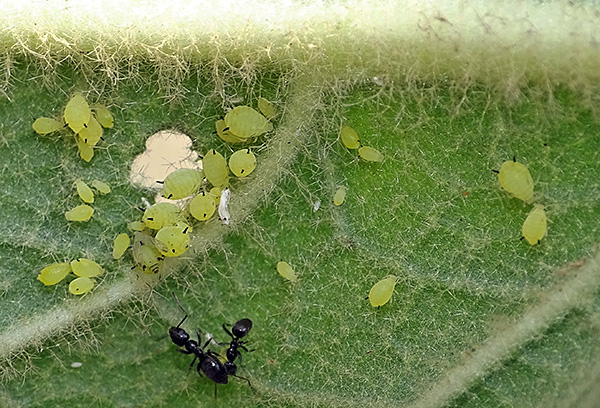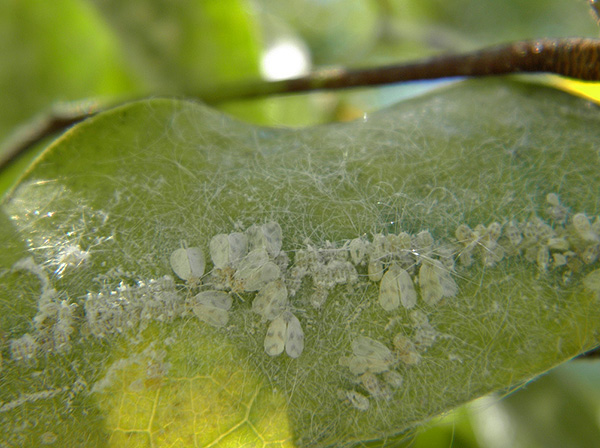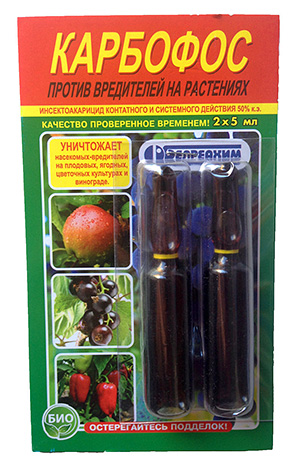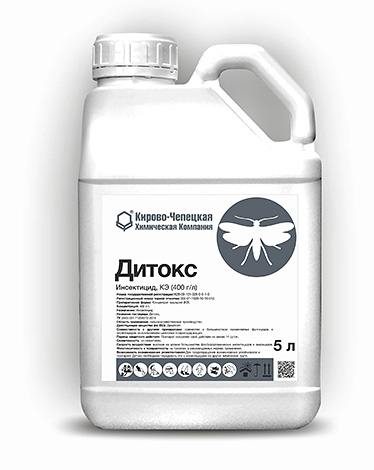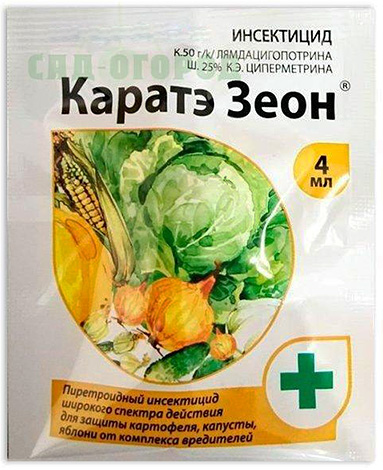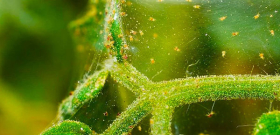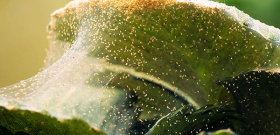
Spider mites (tetranychids) are one of the most dangerous pests of garden crops. Settling on a plant and establishing a large colony here, they are able to destroy even adult, previously healthy bushes. Moreover, young, only germinated plants are very vulnerable to the attack of these pests and can die when infected even under favorable growing conditions - with abundant watering and in an optimal microclimate.
It is not surprising that the appearance of a spider mite on seedlings is a big risk for young plants and a signal for the gardener to urgently take control measures. This is especially true for fairly “tender” plants, the seedlings of which can die even with a slight infestation with spider mites - tomatoes, sweet (bulgarian) peppers, cabbage, eggplants.
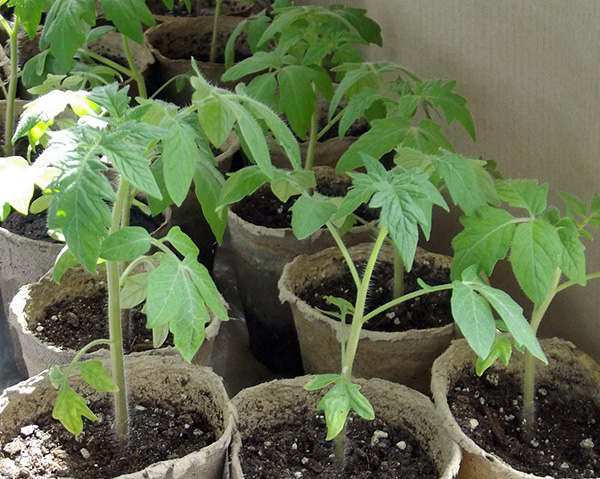
At the same time, today there are many means by which you can get rid of a tick on seedlings very quickly, preventing significant damage to the leaves and dangerous consequences for the plant. To do this, it is enough to detect pests in time and properly treat the seedlings with an effective preparation.
Next, we will see how you can identify spider mites at the earliest stages of plant infection, what means to choose to kill pests and what home control measures give a good result ...
Why are spider mites dangerous for seedlings
The main harm that spider mites cause to plants is malnutrition of the leaves. Each individual of the pest pierces the leaf epidermis to saturate and sucks out the contents of the parenchyma cells, including together with chlorophyll grains. The cell dies after such damage.
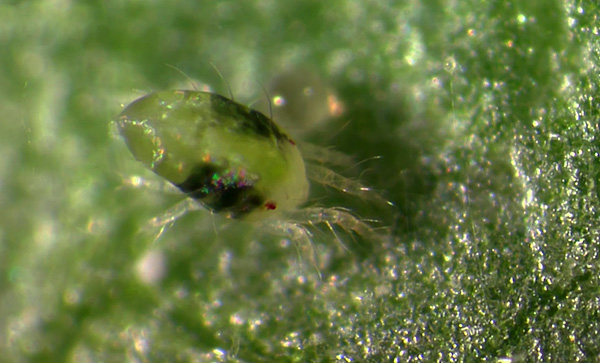
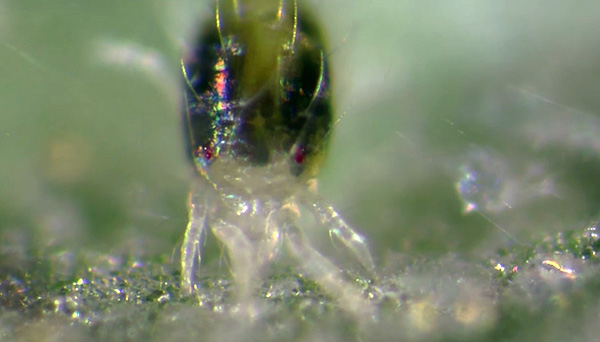
If a large number of individuals parasitize on a leaf at the same time, then as a result, significant areas of the parenchyma appear, consisting of dead cells and having a color different from that of a healthy leaf. These areas gradually grow, merge with each other, and at a certain stage of infection, the leaf almost completely changes color, becomes marbled, brown or yellow.
On a note
It is erroneous to assume that spider mites suck juices moving through the vessels of the leaf. In fact, sap flow occurs through the vessels of the xylem, to the cavity of which the tick cannot reach due to the short length of its chelicerae. However, due to cell damage, tetranychids indirectly affect the flow of sap in the leaf and impair its nutrition. It also speeds up leaf death.
The photo below shows the leaves of tomato seedlings with a strong infection with an ordinary spider mite:
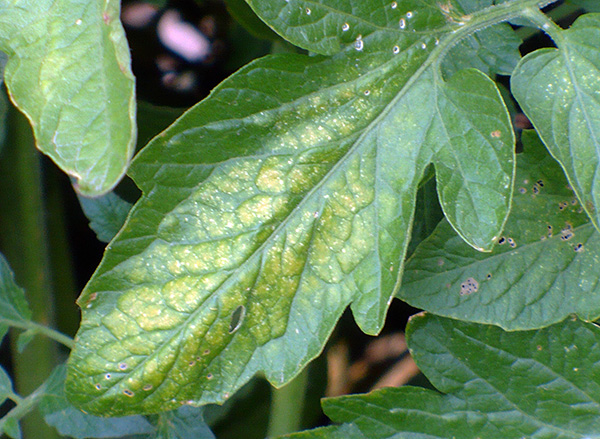
Outwardly, it may seem that the plants are suffering from some kind of viral or fungal disease, since the leaves look damaged from above, and pests are not visible - almost all mites are on the underside of the plates.
When more than 70-80% of the leaf parenchyma is damaged, it dries up and falls off.By this time, the colony of mites has already managed to spread to neighboring leaves and cobweb them and shoots, due to which the fallen leaf remains inside the web, and the mites themselves safely migrate from it to neighboring ones that are still alive and nutritious for them. Saving seedlings at this stage is much more difficult than at the very beginning of infection.
It is also known that due to damage by mites, leaves lose resistance to damage by other pests. In addition, it has been shown that tetranychids can be carriers of infectious plant diseases. For example, on the body of a hawthorn mite, researchers found fungi that cause scab and powdery mildew. According to some reports, spider mites can be carriers of plant viral infections.
It is interesting
The web of tetranych mites does not pose a danger to seedlings. Although in large quantities it will reduce the amount of light reaching the surface of the leaves, however, such a decrease in illumination will not be critical for the plant.
Spider mites reproduce very quickly. An adult fertilized female lives for 2-3 weeks, during which she manages to lay up to 150 eggs - each separately, on the web she has released. The rate of development of eggs and larvae depends on the microclimate, and the full cycle from egg to egg can last from 2 to 8 days (in rare cases longer).
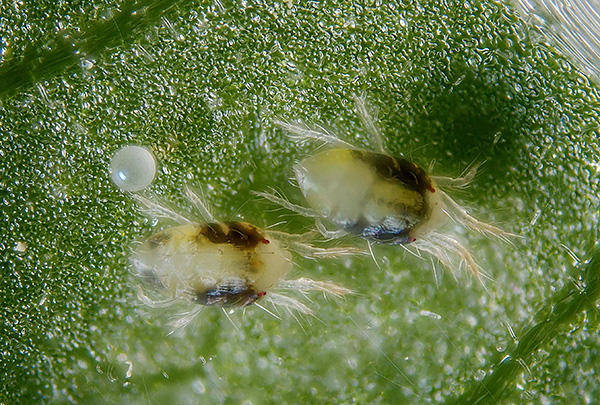
As a rule, seedlings are grown in optimal conditions for ticks, and therefore they multiply extremely quickly here. In 2 weeks, the second generation may appear on the bushes, and the number of pests here will exceed several hundred per square meter.
Such a multitude of sap-sucking mites creates a heavy load on a young, not yet strong bush.In many cases, intensive reproduction of tetranychids can lead to the death of seedlings.
On a note
It is believed that adult plants can die when infected with spider mites only with a lack of water. In this case, the bush simply does not have enough resources to compensate for the loss of part of the vegetative mass with new leaves. Seedlings can die when infected, even with normal water supply.
All types of spider mites equally represent such a danger. Their biology is largely similar, and they harm plants to about the same extent.
However, the following species are considered the most malicious seedling parasites:
- The common spider mite (Tetranychus urticae) is the most common and numerous in Eurasia, and therefore most often affects seedlings;
- Red spider mite (Tetranychus cinnabarinus);
- Two-spot tick (Tetranychus bimaculatus).
The differences between them in appearance and in the characteristics of biology are insignificant, and it is often impossible to identify them without special equipment and tables. But there is no need for this either: the rules for dealing with representatives of different types of tetranychids are the same.
Seedlings of which plants are most often affected by these pests
Spider mites do not show noticeable specialization and preferences for certain types of garden plants grown from seedlings. Due to their small size and low mobility, tetranychids cannot choose on which plants they parasitize, and which ones do not.

As a rule, overwintered female ticks climb those plants that are closest to them. If such a female is in the ground in a pot with seedlings, then she will begin to feed on the seedling that grows in this pot.
Similarly, if a pest accidentally fell on seedlings, then it will feed exactly where it ended up.
At the same time, seedlings of different plants are resistant to spider mites in different ways. For example, zucchini and pumpkins are weakly affected by tetranychids, and if several individuals of the parasite are on the plant, they can die here and not give offspring.
Statistics show that seedlings of plants of the nightshade family - tomatoes, sweet peppers, eggplants and potatoes grown from seeds, as well as young bushes of cabbage, cucumbers and strawberries - suffer from spider mites most often and to the greatest extent.
The photo below shows a strawberry affected by a spider mite:
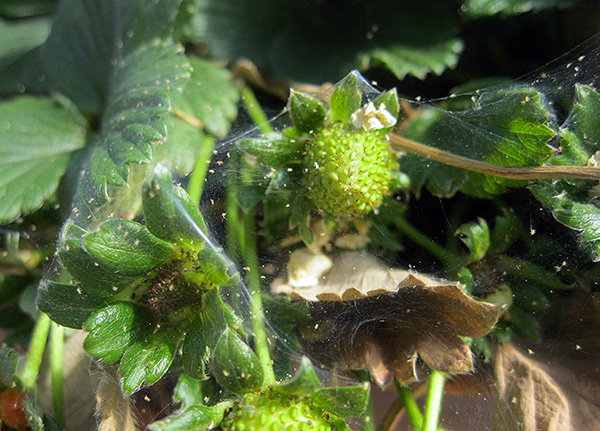
On a note
Partly because of their love of tomato seedlings and partly because the females of the common spider mite turn red before wintering, these pests are sometimes called tomato mites. This, however, is an exclusively popular name.
These pests should not be confused with the brown fruit mite that affects fruit trees - it is sometimes called "rusty" because of the huge number of reddish eggs that form a rusty-red coating on the bark of a tree in autumn.
Umbrella (carrot, celery) and onion plants are relatively resistant to tetranychids. Although they are rarely grown from seedlings.
It is interesting
Onions and garlic have their own specific pest mites: root mites from the Tyroglyphidae family and the four-legged garlic mite Aceria tulipae, notable for having only two pairs of walking limbs.
Quite often, spider mites infect seedlings of fruit trees and shrubs.This is largely due to the fact that such seedlings are obtained from the vegetative parts of adult plants, in the bark of which female ticks often overwinter. In the spring, they simply begin to develop on the same plant on which they overwintered.
To make a short summary, spider mites can be found on almost any seedling.
Differences between spider mites and other plant pests
An inexperienced gardener may confuse spider mites with some other pests that also attack seedlings.
These pests include:
- Aphid - the size of its larvae is comparable to the size of adult spider mites. At the same time, ticks differ in body shape (which can be seen in detail even without a microscope) and shorter legs: aphids literally stand on their feet, while ticks have them on the side. In addition, in the breeding grounds of spider mites, a web always appears, but aphids do not form it. In addition, aphids secrete liquid droplets (the so-called "honeydew") that are clearly visible on the undersides of the leaves, and mites of such secretions do not form;

- The whitefly is a small insect related to scale insects, but similar to butterflies. Noticeably larger than ticks, and their wings can be easily seen with the naked eye. It is the presence of wings that is the most obvious difference between whiteflies and ticks;

- Some caterpillars weaving their webs around their clusters. It is the web that is sometimes taken as a sign of infection with spider mites, but only caterpillars can be inside.

However, of all these pests, spider mites are the earliest. They often begin to multiply long before aphids or butterfly larvae can appear on the plants.This is one of the characteristic distinguishing features of tetranych mites: in early spring, when there is still snow outside the windows, it is they who infect the seedlings.
Another distinguishing feature of mites is the appearance of cobwebs on the leaves. Females begin to release such a web immediately after the start of feeding in order to attach eggs to the threads. At first, the web is not striking, but upon careful examination of the leaves, it is not difficult to notice it.
The photo below shows a typical tetranychid web on tomato leaves:
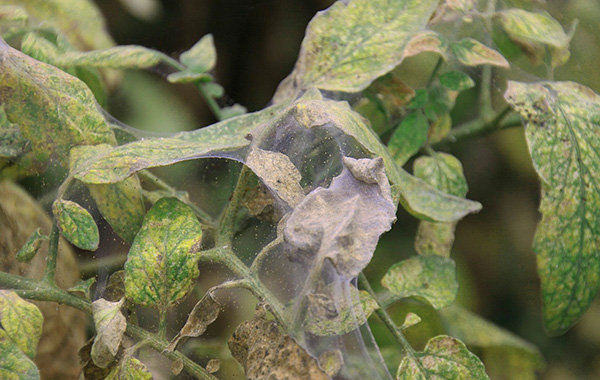
The spider mites themselves look like small mobile "insects" on the leaves. In different populations, the color can vary from white to greenish, and sometimes they even have contrasting spots on the body. These color details are clearly visible in a magnifying glass or microscope.
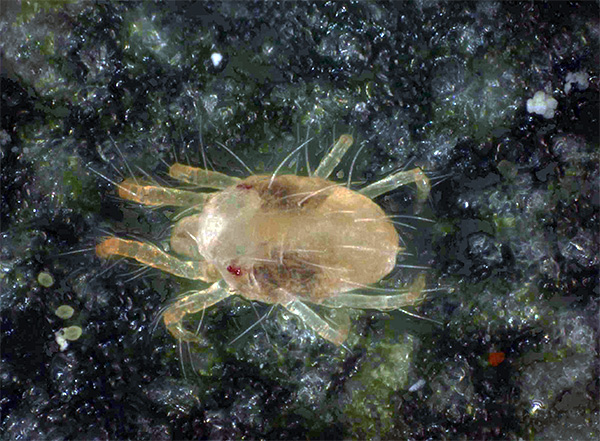
Most of the mites on the plant are on the underside of the leaves, so to search for and detect their seedlings, you need to sort through your fingers, gently bending the leaf up and inspecting its underside. It is useful to do this both at home and in the greenhouse in order to diagnose the infection in time, but it is even more important to inspect the plants in this way before buying in the market or in the store.
Important: a well-marked cobweb appears on the leaves during the mass reproduction of ticks and with a large number of adult females on seedlings. At this stage of their reproduction, seedlings are already beginning to die. Therefore, it is desirable to identify pests and start fighting them earlier, when there are practically no cobwebs on the leaves.
Causes of plant infection
Tetranychids can get on seedlings in different ways. Knowing these ways of infection, you can take effective measures to protect plants.

Most often, mites get on seedlings in the following ways:
- They end up in the ground, which is collected in pots and in which seeds are planted. This land for seedlings can be collected in the garden or garden under the trees, where the leaves fell with the females ready for wintering. These females hid for the winter in the upper layer of soil, which is collected to fill seedling pots. As soon as the earth is warm under the film, the mites wake up and get out first to the surface, and then to the emerging seedlings, and begin to feed on them and lay eggs;
- They end up in a pot with mulch;
- They fall on seedlings from domestic plants;
- They fall on seedlings from structures in greenhouses.
In any case, ticks cannot travel long distances on their own. As a result, most often it is the person who grows this seedling who is to blame for the infection of seedlings with them, one way or another.
Ways to deal with spider mites
Tetranychid on seedlings can be successfully destroyed by several methods, each of which is optimal in certain conditions.
The easiest way to fight is the mechanical destruction of pests. They can be crushed with fingers or a simple eraser, and on young seedlings with a small amount of leaves, this can be done relatively quickly. At the same time, such destruction of the pest takes a lot of time, and with a large number of seedlings (more than 50 bushes) and on already large bushes, the method is irrational.
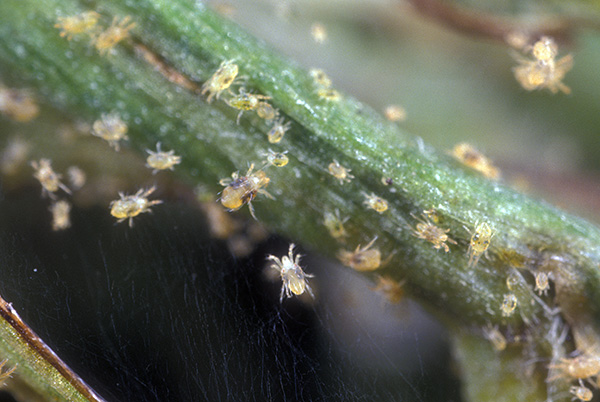
Also, young bushes can be washed with a stream of water - if there are few cobwebs on them, then the mites are easily washed off from the surface of the leaves. However, it can be technically difficult to carry out this procedure due to the risk of flooding the pots and damaging the still tender bushes.
The gold standard for spider mite control is spraying plants with acaricide chemicals. With such spraying, substances enter the parasites, which quickly penetrate the nervous system of ticks and lead to their death. Moreover, the speed of action of these drugs is very high - in places where the drug settles on the leaves, ticks die literally within a few minutes. For seedlings, these substances are harmless, and by the time of flowering and fruiting, they are completely washed off from the treated leaves.
On a note
In households, a variety of folk remedies are often used to combat spider mites: soap solution, alcohol, decoctions or infusions of garlic, onion peel, potato tops, yarrow herb, horseradish, wormwood. They wipe the leaves on which pests are found. Some of these remedies are quite effective (for example, alcohol and infusion of potato tops), while others often do not give any result.
Finally, the most promising, harmless and effective method of biological control of spider mites is considered today. It consists in releasing natural enemies of tetranychids onto plants, which eat ticks at all stages of development, including eggs. However, as we will see below, this method is of little use for home conditions.
As a rule, in small household or greenhouse farms, ticks on seedlings are first tried to be mechanically destroyed (manually or with water). If this does not help get rid of pests or at least restrain their reproduction, then they are treated with acaricides.
Acaricidal preparations, their effectiveness and rules of use
To destroy spider mites, insecticidal preparations based on pyrethroids and organophosphorus compounds are used with sufficient success. Tetranychids are quite sensitive even to old (from the point of view of the date of development) and widespread substances - for example, to malathion (karbofos), cypermethrin, chlorpyrifos, and therefore relatively inexpensive means can be used to combat them.

So, the most common means of dealing with spider mites include:
- Fitoverm is a drug based on aversectin C. It can be bought in different packages, from 1 to 5 liters. The main distinguishing feature and advantage of Fitoverm is its rapid decomposition and inability to penetrate into the internal tissues of plants. That is, the seedlings treated with it will not accumulate insecticide, and already 2-3 days after spraying it will be clean from "chemistry". In addition, Fitoverm has a relatively low consumption rate, due to which even a large number of seedlings can be treated with a relatively small amount of funds;

- Ordinary garden Karbofos or preparations based on the same active substance - Antiklesch, Bunchuk, Iskra M, Fufanon. Despite the fact that karbofos (aka malathion) has been used in agriculture for several decades, it continues to be effective in the fight against spider mites;

- Ditox is an agent based on dimethoate, a representative of the class of organophosphorus compounds;

- Karate-Zeon is one of the most powerful drugs, the active ingredient of which is lambda-cyhalothrin. It is highly toxic not only for tetranychids, but also for any other invertebrates (including ants, bees);

- Kynphos containing two pesticides of different classes - pyrethroid beta-cypermethrin and FOS dimethoate. Due to this, the probability of resistance of ticks to the agent is practically zero;

- Clipper, the active substance of which is bifenthrin pyrethroid. It poisons spider mites very quickly, but requires caution and safety precautions when using.

On a note
Some experts also indicate bitoxibacillin as an acaricide, a drug based on a culture of bacteria that causes indigestion in butterfly caterpillars and their starvation. Presumably, bitoxibacillin can have the same effect on ticks, but detailed studies in this direction have not yet been carried out.
For the treatment of seedlings, it is sometimes advisable to use any inexpensive acaricidal agent available. In most cases, they are quite effective in destroying both spider mites and other possible pests on young plants. After processing, you need to evaluate the result: if most of the ticks died, but some remained alive, then it is enough to treat the seedlings with the same agent again. If the ticks did not die at all, then you need to use the drug with another active ingredient.
After the destruction of ticks, further treatment of seedlings is not required. If at least part of the leaves remained intact, then the bush is highly likely to recover.
Leaves that are completely “beaten” by ticks, obviously drying out, should be cut and burned. This allows you to save intact bushes and parts of an already affected plant from re-infection with pests, if some of their individuals survived in dry leaves.
Biological methods of dealing with spider mites
In large farms, their biological enemies, phytoseiulus and neoseiulus mites, are used to destroy spider mites. These arthropods feed on spider mites in a priority order, and adult phytoseiulus prey on adult tetranychids and their nymphs, and small nymphs find and suck out the eggs of spider mites.
The photo below shows a phytoseiulus attack on a spider mite:
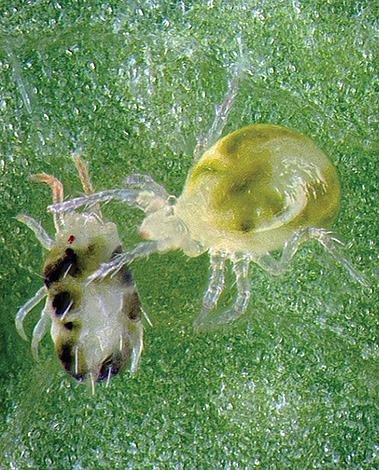
Practice shows that due to the high reproduction rate and high voracity, these predatory mites very quickly destroy their "spider relatives" on any plants. At the same time, their use is completely harmless to people, does not lead to the accumulation of hazardous substances in the harvested fruits, and is quite simple from a technical point of view: ticks are simply released from transport containers onto plants in the right quantities, and they themselves begin to attack pests, gradually multiplying and spreading. throughout the farm.
However, phytoseiulus and neoseiulus are not suitable for home conditions and for protecting seedlings from spider mites. They are expensive to buy, and they do not survive the winter in mid-latitude conditions, and therefore their use is rational only in large industrial farms that are able to buy crops of these predators annually.
How to prevent infection of seedlings
Protecting seedlings from spider mites is quite difficult. Females wintering in the soil can easily end up in plant pots, and already active individuals can get here from indoor bushes. And if getting from indoor plants can be prevented by covering the seedlings with a film and watching the bushes themselves in pots, then it is problematic to destroy all the mites in the soil.
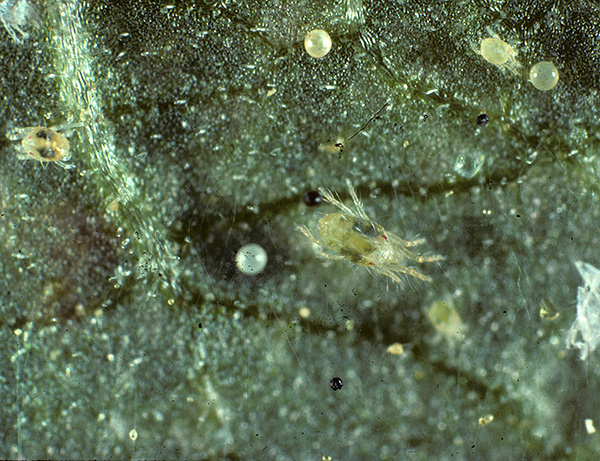
On a note
You can kill all wintering individuals in the ground by heating it to 60 ° C and holding it at this temperature for 1-2 hours. This can be done with warm water.
If seedlings are purchased on the market, then it is useful to inspect it with a magnifying glass when buying. It is the underside of the leaves that is subject to inspection, on which it is necessary to look for single individuals of the spider mite.
When growing seedlings in a greenhouse, the soil should be loosened before winter and before sowing seeds, and the location of crops in different beds should be changed annually. This will make it possible to destroy some of the individuals wintering directly in the greenhouse. Here, the seedlings for the first few weeks need to be grown under a film in order to prevent ticks from getting on it from other plants.
Regardless of the set of preventive measures, all seedlings should be inspected every few days. If tiny whitish dots or thin cobwebs begin to appear on the underside of the leaves, then you need to arm yourself with a magnifying glass, identify the pest and start the fight as early as possible to prevent mass reproduction of tetranychids on already flowering or fruiting plants.
Spider mite on seedlings and flowers: how to save plants

